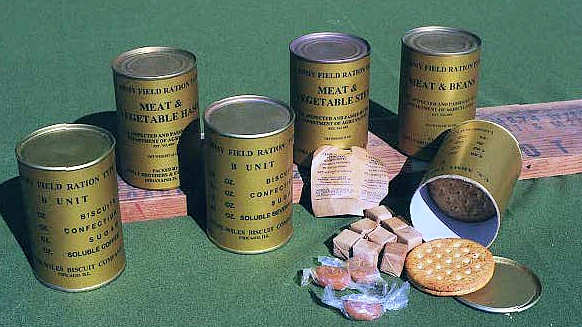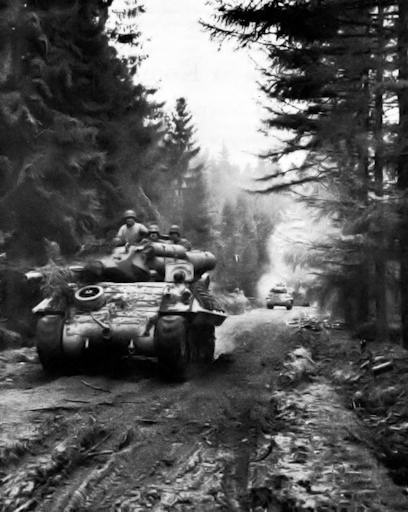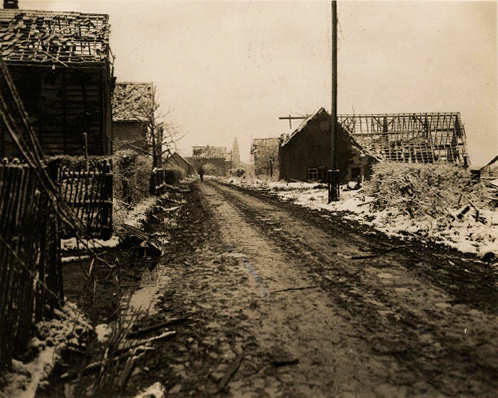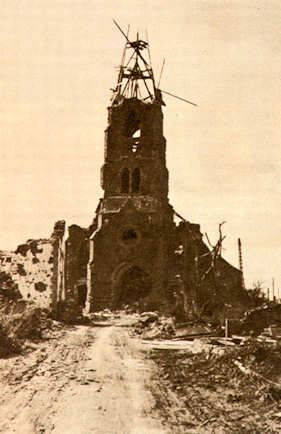in support of the 28th Infantry Division
in the vicinity of Vossenack, Germany
2-9 November 1944 - (Rhineland Campaign)
By Major John J Lavin

FINAL PREPARATIONS FOR THE OFFENSE
The next two days (31 October and 1 November) were spent rounding out unfinished details. The gun companies were registered, F.D.C.'s and gun crews organized to fire on a 24 hour schedule, three days emergency rations on each destroyer were verified and three rounds per gun of a new type high velocity armor piercing ammunition (HVAP) was placed in ready racks. All troops were fed "B" rations while in indirect fire positions.

Tentative plans "A" and "B" for the employment of the battalion in its primary mission were drawn up after a conference with the officers of Reconnaissance Company and a personal reconnaissance by the battalion commander and his operations officer. These plans fitted in with the over-all anti-tank and traffic circulation plans of the division and were approved. Plan "A" was designed to stop tank attacks from the direction of HURTGEN, which was considered the main route for enemy armored attack into the division area. Plan "B" was designed to block the east and south routes of approach into the area, although no routes of approach from the east could be deducted from map and aerial photograph studies. Primary positions for both plans were generally in the GERMETER - VOSSENACK area for 1 company with second company acting as reserve and adding depth at critical road junctions. Company commanders were furnished copies of the plans and an operations code covering the division area to include the objectives. Questions relative to both the plans and code were answered at the time of issue. 17
Information as to importance of the operation was at this time lacking, although it was learned that plans were made to support this operation to the north and south. Up until the jump-off time no enemy armor was reported in the area. 18

M10 tank destroyers of the 893d Tank Destroyer Battalion,
moving up over a narrow muddy forest road west of Germeter.
Meanwhile supply elements were concerned with hauling three inch ammunition to the gun positions, and in one instance a road of empty ammunition boxes was constructed over soggy ground in order for the trucks to reach a platoon firing position in B Companies area. 19
Reconnaissance company established liaison with the 294th Engineer Battalion manning road blocks along road and trails in the northern section of the division area, generally 3000 yards west of the town of HURTGEN. 20 (See Map D)
Prior to H-hour the division received an additional mission to attack southwest from SCHMIDT, take STECKENBORN and aid in the defense of the KESTERNICH area which troops to the south were to assault shortly. 21 This order had no effect on the immediate dispositions or plans of the battalion.
THE BATTALION SUPPORTS THE ATTACK
At 0800 hours (H-60) 2 November 1944 Companies "B" and "C" began their schedule of supporting fires. These concentrations covered the entire division zone, particularly known and suspected enemy infantry positions, and were delivered in considerable volume.
One hour later the attack jumped off on schedule and the fires of the battalion for the rest of the day were mostly infantry support missions. In the north of the division zone the 109th Infantry made good progress averaging 500 yards or more through barbed wire, Schu-mines and booby traps all covered by machine gun and small arms fire. In the center, one battalion of the 112th Infantry, supported by elements of the 707th Tank Battalion jumped off from positions in the woods just west of the GERMETER road, took VOSSENACK by early afternoon and remained there as planned. To the south the 110th Infantry received considerable artillery and mortar fire, which combined with the enemy stubbornly defending concrete pillboxes and extensive entrenchments limited their advance to 200 yards. 22
About noon this first day, when it was apparent that the attack on VOSSENACK was meeting with success, the commander of the 893d Tank Destroyer Battalion initiated plans for the forward displacement of the two gun companies. At 1300 hours the first report of enemy armor was received from Division Artillery. This report indicated 10 enemy tanks had moved into the woods southeast of KLEINHAU, and shortly thereafter another report was received stating that 2 enemy tanks had moved into the woods northeast of the same town. 23 (See Map D)

Vossenack, 15 November 1944.
During the day elements of Reconnaissance Company performed missions assigned by battalion. They reported that the roadblocks along the north of the division zone were in some cases involved in firefights but, since our engineers were about 50 strong at each position, supported by Anti-tank guns, 50 caliber machine guns and had mined and booby trapped the area, no threat could be foreseen from that direction. They also reported that the engineers following the 112th Infantry had swept the trail southwest of RICHELSKAUL and road as far as the church in VOSSENACK. (See Map D)

Reconnaissance Company also selected tentative positions for the gun companies some 2500 yards west of RICHELSKAUL. The Pioneer Platoon removed mines and filled trees in the selected areas to prepare them for indirect firing.
Up until 1700 hours the gum companies fired some 2500 rounds, "B" Company firing over half of this amount, most of it being infantry supporting fire. 24
During the night 2-3 November the companies fired interdictory and harassing fires.
On 3 November plans for displacement were approved, the actual movement to the new positions to take place the following morning. During the day the battalion laid wire from the selected site to the nearest artillery unit for fire control, established liaison and arranged for survey. An artillery observer reported three enemy tanks 1000 yards north of HURTGEN at 1100 hours. This was only enemy armor reported in the area during the day. 25 During the night 3-4 November Companies fired interdictory and harassing fires. One gun of "C" Company developed a leaking recoil system and was ordered out of action.
Two battalions of the 112th Infantry had moved out of this date, and after some minor skirmishes one battalion was in KOMMERSCHEIDT and the other moved on to SCHMIDT. The division had reached its objective and had completely surprised the enemy in the SCHMIDT area. However the overall picture in the division left much to be accomplished. SCHMIDT had not been entirely cleared of the enemy. By nightfall only three tanks of the 707th Tank Battalion had managed to cross the narrow, steep, unimproved trail the infantry had used to cross the KALL River valley. This was the route to be used in supplying the regiment in SCHMIDT. The battalion of the 112th Infantry remaining in VOSSENACK was receiving accurate enemy artillery fire. To the north the 109th Infantry was heavily engaged in see-saw battles, repulsing one major counterattack. To the south the 110th Infantry could make only limited gains in the heavily fortified forest. Casualties in the assaulting units were heavy. 26

